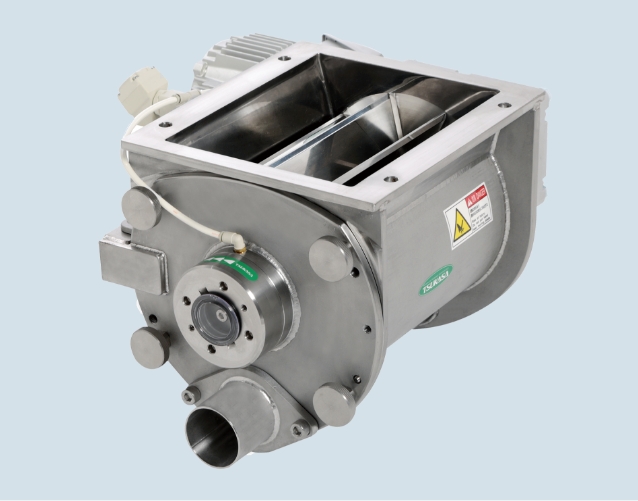Handling Process
Constant conveyance and constant supply, realizing stable discharge
Constant conveyance and constant supply, realizing stable discharge
Quantitative supply equipment
PowRotor Light-weight, Blow-through, Sanitary Model (TRV-LSF)
Constant discharge device which functions exclusively as the feed source for pneumatic conveyance
Air-purge specification
Sanitary specifications : Four-point bolting
Sanitary specifications : Four-point bolting
When ordering, please provide us with the following information:
1. Model
2. State of material to be transported
3. Amounts of feed and discharge
4. Upstream and downstream equipment and pressure differentials
5. Installation site
6. Operating times
7. Voltage and frequency
1. Model
2. State of material to be transported
3. Amounts of feed and discharge
4. Upstream and downstream equipment and pressure differentials
5. Installation site
6. Operating times
7. Voltage and frequency
Features
⚫︎A Simple design with motor directly connected structure and achieve about half of the space saving compared with conventional chain-driven.
⚫︎By reducing of the weight of the main body, it is very easy to handle.
⚫︎For sanitary structure, it is excellent in sanitation.
⚫︎By reducing of the weight of the main body, it is very easy to handle.
⚫︎For sanitary structure, it is excellent in sanitation.
Applications
⚫︎This model functions exclusively as the feed source for pneumatic conveyance, and the conveyance piping for it is mounted directly on the valve unit.
⚫︎For pneumatic conveyance Type
⚫︎Because of sanitary specification, decomposition washing is possible.
⚫︎For pneumatic conveyance Type
⚫︎Because of sanitary specification, decomposition washing is possible.
Specifications
⚫︎Material: Stainless steel, with welding scale electrolytic-removed
⚫︎P400 buffed finish for powder-contacting areas, 3-side edge treatment of rotor
⚫︎Options: Raised bottom rotor, helical rotor, and special surface treatment (Standard equipment for air-purge specification)
⚫︎P400 buffed finish for powder-contacting areas, 3-side edge treatment of rotor
⚫︎Options: Raised bottom rotor, helical rotor, and special surface treatment (Standard equipment for air-purge specification)



